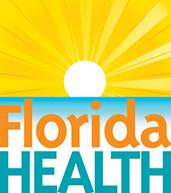It's a New Day in Public Health.
The Florida Department of Health works to protect, promote, and improve the health of all people in Florida through integrated state, county, and community efforts.
Florida Flooding Preparedness
Contact: Florida Health
- 850-245-4444
- health@flhealth.gov
-
Mailing Address
Florida Health
4052 Bald Cypress Way
Tallahassee, FL 32399
 Understanding and Preparing for Flooding
Understanding and Preparing for Flooding
Flooding, one of the most frequent and costly natural disasters, occurs when water temporarily overflows onto normally dry land. It can result from heavy rain, storm surges, coastal storms, and even dam or levee failures. Flooding can develop gradually or strike quickly as flash floods, leaving little time to react. Understanding the types of flooding and how to prepare can help protect your family, home, and community.
- Here are some common types of flooding:
- River Flooding: This happens when rivers exceed their capacity due to prolonged rainfall or melting snow.
- Flash Flooding: Sudden, intense rainfall can overwhelm drainage systems and create dangerous, fast-moving water with little warning.
- Coastal Flooding: High tides, storm surges, and hurricanes often lead to flooding in coastal areas.
- Urban Flooding: Heavy rain in cities can overwhelm drainage systems, leading to water pooling in streets and homes.
Flood Risks in Florida
Florida’s flat landscape and low elevation make it highly susceptible to flooding, especially during the rainy season and hurricanes. Storm surges and heavy rainfall can quickly cause significant flooding, with rivers, lakes, and wetlands increasing the risk of water overflow into populated areas.
Urban areas face added risk from impervious surfaces, while coastal communities are impacted by sea level rise and tidal flooding. Even inland regions can experience flash floods during heavy rains. Understanding local flood risks is crucial for effective preparation.
The Impact of Storm Surges
Storm surges, caused by powerful hurricanes and tropical storms, are one of Florida's most significant flood threats. These sudden rises in sea level can inundate coastal areas, overwhelm drainage systems, and lead to devastating property damage. Combined with heavy rainfall, storm surges can extend flooding far beyond the coastline, impacting both urban and rural communities. Preparing for storm surge risks is essential to safeguarding lives and property during hurricane season.
How to Stay Safe
- Before a Flood:
- During a Flood:
- After a Flood:
- Assess your flood risk by checking local flood maps.
- Purchase flood insurance: most standard home insurance policies don’t cover flood damage.
- Prepare an emergency kit with supplies like food, water, medications, and important documents.
- Develop an evacuation plan and practice it with your family.
- Stay informed by monitoring alerts from reliable sources like the National Weather Service.
- If evacuation is advised, leave immediately and follow designated routes.
- Never walk or drive through floodwaters. Just six inches of moving water can knock a person down, and a foot of water can sweep away vehicles.
- Only return home when authorities confirm it’s safe.
- Avoid contact with floodwater, which may carry harmful contaminants or electrical hazards.
- Document property damage with photos and contact your insurance provider for assistance.
Additional Resources
Stay Prepared and Stay Safe
Floods can strike without warning, but being proactive can make all the difference. Know your local flood risks, invest in protective measures, and have an emergency plan in place. Stay informed through reliable sources and act swiftly during emergencies to safeguard your loved ones and property.
Preparation today ensures resilience tomorrow. By taking the time to understand flood risks and staying ready, you can minimize disruptions and recover more quickly when faced with rising waters. Stay vigilant, stay prepared, and stay safe.
Disclaimer: The links and content provided on this page are for informational purposes and your convenience. The Florida Department of Health (DOH) does not endorse, approve, or guarantee the products, services, or opinions offered on external websites. Furthermore, the DOH is not responsible for the accuracy, content, or availability of these external sites. For questions or concerns, please contact the external site directly.



Connect with DOH